Commodore was the third player in the 68000-based personal computer market, going up against the Apple Macintosh and Atari ST. Commodore had acquired Amiga in 1984.
Jay Miner had been with Atari since the 1970s and helped develop the Atari 2600 game console and Atari’s 8-bit computer line. Miner wanted to design a new system around the Motorola 68000, but Atari management only wanted to milk the 6502 at that time, so he left Atari. In 1982, Larry Kaplan hired Miner to head hardware development for a new gaming console, code named Lorraine. After Kaplan left, the company relaunched as Amiga Corp.
Miner was able to demo his new hardware at the January 1984 Consumer Electronics Show (CES) and again at the June 1984 CES. Because of the 1983 video game crash, a new gaming platform was a tough sell. Atari provided Amiga with a $500,000 one-month loan. If Amiga didn’t repay it on time, Atari would own its technology.
Commodore had no plan of its own for a next generation computer and looked at Amiga, which it purchased for $24 million, as its entry into the 16/32-bit world.
3 Kinds of Memory
There are three different classes of memory used in Amiga computers: Chip RAM, Fast RAM, and Zorro RAM.
Chip RAM is shared by the CPU and the Amiga’s custom chipset. Because the 68000 CPU can only access memory on every other clock cycle, the chipset usually accesses memory on the alternate clock cycle. However, at high resolutions and bit-depths, the CPU can be blocked from accessing Chip RAM. Chip RAM ranges from 256 KB to 2 MB depending on the model and memory upgrades.
Fast RAM is not share with the chipset; only the CPU can use it. Thus, the CPU cannot be locked out of access to Fast RAM.
Zorro RAM connects via the Zorro II (16-bit) or Zorro III (32-bit) bus in the Amiga.
Amiga 1000, July 1985
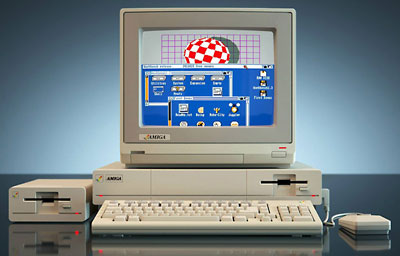 Commodore became the third player in the 680×0 home computer market, after Apple and Atari. It acquired Amiga in 1984, and Amiga would be the first of the three companies to have an operating system with pre-emptive multitasking.
Commodore became the third player in the 680×0 home computer market, after Apple and Atari. It acquired Amiga in 1984, and Amiga would be the first of the three companies to have an operating system with pre-emptive multitasking.
The Amiga 1000 (A1000) was the most advanced graphics and audio system on the market when it was introduced on July 23, 1985. It ran its 68000 CPU at 7.16 MHz but included additional chips to offload a lot of tasks handled by the CPU in Macs and Ataris. The A1000 was the first multimedia computer. It included composite video output for older monitors or recording to videotape.
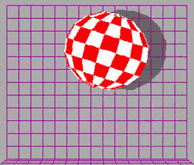 Nothing got people’s attention like the Amiga Boing Ball demo. It showed a red and white ball bouncing and spinning – and casting a shadow on a grid background. It did all this smoothly while other tasks were happening in the background.
Nothing got people’s attention like the Amiga Boing Ball demo. It showed a red and white ball bouncing and spinning – and casting a shadow on a grid background. It did all this smoothly while other tasks were happening in the background.
The A1000 shipped with just 256 KB of Chip RAM and could be upgraded to 512 KB. Later upgrades allowed taking it to 8.5 MB. Price with a color monitor was $1,595 – twice as much as the monochrome Atari ST and $1,200 less than the Fat Mac.
Due to production problems, the Amiga 1000 didn’t ship in quantity until 1986, and Commodore sold 35,000 Amigas that year. In March 1990, Commodore offered $1,000 for Amiga 1000 owners to trade up to the Amiga 2000.
Amiga 2000, March 1987
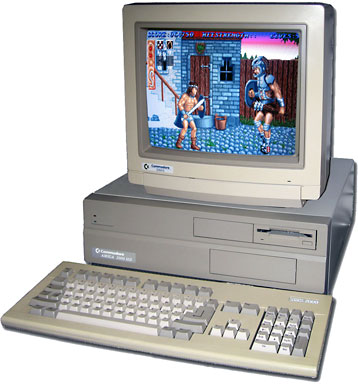 The Amiga 2000 (A2000) replaced the A1000 in March 1987. The A2000 case is taller to make room for two 3.5″ drive bays and one 5.25″ drive bay. The A2000 was the first Amiga to accept expansion cards without an add-on expansion chassis. It has five Zorro II card slots and four PC-style ISA slots – two 8-bit slots and two 16-bit slots. All this with a $1,500 price tag!
The Amiga 2000 (A2000) replaced the A1000 in March 1987. The A2000 case is taller to make room for two 3.5″ drive bays and one 5.25″ drive bay. The A2000 was the first Amiga to accept expansion cards without an add-on expansion chassis. It has five Zorro II card slots and four PC-style ISA slots – two 8-bit slots and two 16-bit slots. All this with a $1,500 price tag!
The A2000 shipped with 1 MB of Chip RAM and supports up to 9 MB total RAM. Its graphics were second only to the Macintosh II, which was much, much more expensive.
The Amiga 2000HD was an Amiga 2000 with an A2901 MFM hard drive controller and an MFM hard drive, usually 20 or 40 MB and typically a Seagate.
Amiga 500, April 1987
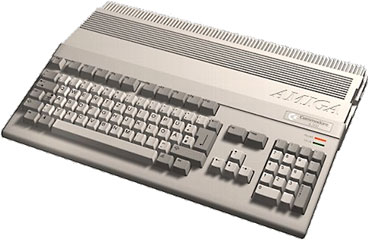 The Amiga 500 (A500) was Commodore’s first entry-level Amiga, intended to compete with the Atari 520ST. It had 512 KB of Chip RAM (1 MB maximum), ran its 68000 CPU at the same 7.16 MHz as the A1000 and A2000. It went on sale in the Netherlands in April 1987, the rest of Europe in May, and in the States in October, where it retailed at $699.
The Amiga 500 (A500) was Commodore’s first entry-level Amiga, intended to compete with the Atari 520ST. It had 512 KB of Chip RAM (1 MB maximum), ran its 68000 CPU at the same 7.16 MHz as the A1000 and A2000. It went on sale in the Netherlands in April 1987, the rest of Europe in May, and in the States in October, where it retailed at $699.
While the more expandable Amigas were sold only by computer dealers, the Amiga 500 was sold by mass market retailers – just like the Commodore 64 had been. The A500 became the most popular Amiga, selling 6 million units, and was widely viewed as a gaming computer, not just a machine for graphic hobbyists.
The Amiga 500 remained in the line until mid 1992, when it was replaced by the Amiga 600.
Amiga A2286 Bridge Board, December 1988
The A2286 board contains an 8 MHz 80286 CPU, and the kit includes a 1.2 MB 5-1/4″ floppy drive, allowing Amiga 2000 to run IBM PC and AT software.
Amiga 2500
The Amiga 2500 is an Amiga 2000HD with a 14 MHz 68020 or 25 MHz 68030 CPU upgrade. It is not a true 32-bit computer.
Amiga 1500, 1990
The Amiga 1500 was a UK-only model aimed at the lower end of the market. In reality, the A1500 was an A2000 with two 3.5″ floppy drives and no hard drive, which helped get the price down to £999 (VAT included). The A1500 sold very well, and there was an option to add a hard drive, which would make it fully equivalent to the A2000.
Amiga 3000, June 1990
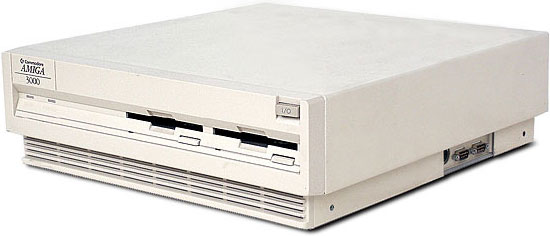 The Amiga 3000 was the first Amiga designed from the ground up as a 32-bit machine using the Motorola 68030 CPU. It was intended as a high-end workstation and retailed at $3,495. The base model had a 16 MHz CPU and 2 MB of memory; the top-end version used a 25 MHz 68030. It shipped with AmigaOS 2, which was more visually attractive than earlier versions.
The Amiga 3000 was the first Amiga designed from the ground up as a 32-bit machine using the Motorola 68030 CPU. It was intended as a high-end workstation and retailed at $3,495. The base model had a 16 MHz CPU and 2 MB of memory; the top-end version used a 25 MHz 68030. It shipped with AmigaOS 2, which was more visually attractive than earlier versions.
Like the 40 MHz, $10,000 Mac IIfx (also introduced in 1990), the A3000 supports DMA access on the SCSI II bus, freeing the CPU from that task. It was compatible with most Amiga peripherals, but internally it had four 32-bit Zorro III expansion slots rather than the 16-bit Zorro II slots of the A2000.
Commodore chose to use ZIP memory chips in the A3000, a direction the rest of the industry did not follow, making it costly and difficult to find memory upgrades. The A3000 supports up to 2 MB of chip RAM, 16 MB of “fast” RAM, 128 MB on a CPU card, and up to 2 GB using Zorro III expansion cards.
The A3000 has improved support for VGA monitors via its “display enhancer” technology. Variants include the A3000UX, which shipped with AT&T Unix System V Release 4, and the A3000T, a tower version.
Commodore was developing an A3000+ with the AT&T DSP 3210 signal processing chip and reached prototype stage before nixing it. The DSP 3210 ended up in the Macintosh Centris 660AV and Quadra 840AV, released in July 1993.
Commodore CDTV, March 1991
The CDTV was an attempt to turn the Amiga 500 into the hub of your home entertainment center. The system was packaged to look like a stereo component and had a built-in CD-ROM drive. We only mention it here because it was an Amiga beneath the skin.
Amiga 500+, September 1991?
 The Amiga 500 was introduced in April 1987 and replaced by the 500+ in late 1991. The 500+ was a cost reduced version of the A500 with an Enhanced Chip Set and shipped with AmigaOS 2.04. It looked almost identical to the earlier version.
The Amiga 500 was introduced in April 1987 and replaced by the 500+ in late 1991. The 500+ was a cost reduced version of the A500 with an Enhanced Chip Set and shipped with AmigaOS 2.04. It looked almost identical to the earlier version.
One of the A500 Plus’ few improvements over the A500 was 1 MB of base memory with support for up to 10 MB of memory, a bit better than the 512 KB base memory and 9 MB ceiling of the A500.
The A500 Plus was never sold in the US. It was replaced by the A600 in summer 1992.
Amiga 600, March 1992
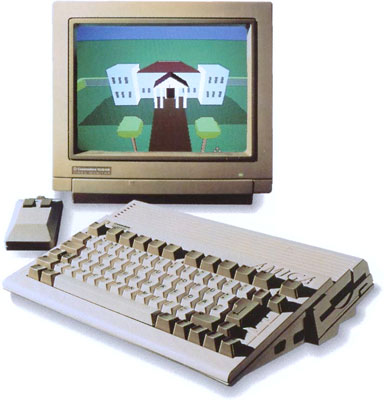 The Amiga 600 is essentially an Amiga 500+ with room for an internal hard drive. It was the last 68000-based Amiga, still running at the same 7.13 MHz speed as the Amiga 1000. Whatever the reason, Commodore left off the numeric keypad that was on the A500 and A500+, making some games that used these keys unusable.
The Amiga 600 is essentially an Amiga 500+ with room for an internal hard drive. It was the last 68000-based Amiga, still running at the same 7.13 MHz speed as the Amiga 1000. Whatever the reason, Commodore left off the numeric keypad that was on the A500 and A500+, making some games that used these keys unusable.
In typically confusing Commodore Amiga fashion, the A600 supports up to 2 MB of “chip” memory and 4 MB of “fast” memory (via a PC Card slot). Third-party upgrades can go beyond that.
Amiga 4000, October 1992
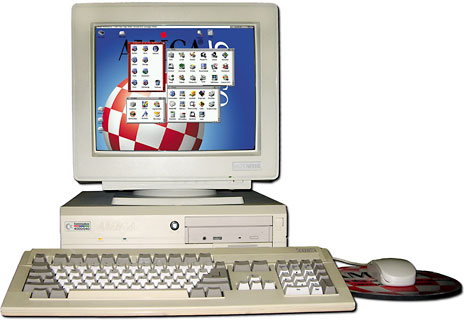 With the Amiga 4000, Commodore jumped into the 68040 world with a new top-end model in October 1992. The A4000/040 uses a 25 MHz 68040 CPU and retained the system architecture of the A3000, the most significant difference being dropping SCSI in favor of less costly IDE. The A4000 shipped with AmigaOS 3.0.
With the Amiga 4000, Commodore jumped into the 68040 world with a new top-end model in October 1992. The A4000/040 uses a 25 MHz 68040 CPU and retained the system architecture of the A3000, the most significant difference being dropping SCSI in favor of less costly IDE. The A4000 shipped with AmigaOS 3.0.
In April 1993, a less costly 25 MHz 68030-based model, the A4000/030, was introduced.
The A4000 was the first model to use Amiga’s new 32-bit Advanced Graphics Architecture (AGA), which supports 24-bit color – a big step up from the 12-bit 4,096 color palette of the past. For the first time, all color modes were available at all resolutions, another big improvement.
The A4000 shipped with 2 MB of chip memory and supports up to 16 MB of fast memory. Third-party developers created faster 68040 upgrades, 68060 upgrades, and even PowerPC upgrades for the A4000.
Amiga 1200, October 1992
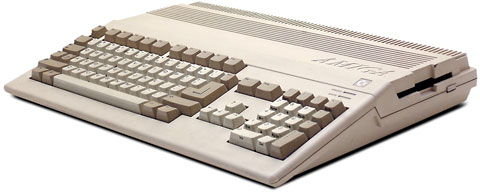 The Amiga 1200 replaced the A600 just seven months after its release. It brought back the numeric keypad from the A500 that had gone missing when the A600 was released.
The Amiga 1200 replaced the A600 just seven months after its release. It brought back the numeric keypad from the A500 that had gone missing when the A600 was released.
The big improvement was moving from a 68000 CPU to the more powerful 68020 – and moving from 7.1 MHz to 14 MHz as well. The A1200 included 2 MB of chip memory in its base configuration, and you can add 8 MB of fast memory. It has the same AGA graphics chipset as the A4000.
The A1200 didn’t sell well and was Commodore’s last low-end model.
Amiga CD32 console, September 1993
Amiga A4000T, 1994
The Amiga 4000T, an expanded tower version of the A4000, was released in 1994, the last new computer produced by Commodore – and in limited number, as Commodore was on life support. The A4000T has both SCSI and IDE support on the system board. The original A4000T uses a 25 MHz 68040, and in 1995 a top-end model with a 50 MHz 68060 was introduced by Escom.
The End?
Commodore shut down Amiga and filed for voluntary liquidation in April 1994. Escom purchased Commodore International in 1995, but Escom overextended itself and declared bankruptcy on July 15, 1996.
Amiga, Inc., was founded later in 1996. Gateway acquired the Amiga trademark and technologies in 1997. Gateway licensed the technologies to Amiga, Inc. in 1999. Amiga, Inc., also purchased the Amiga trademarks and copyrights.
MorphOS was designed as a replacement for AmigaOS and first released in 2000. MorphOS runs on may G4 and G5 Macs, and the most recent version, 3.9, was released on June 19, 2015.
Keywords: #amiga #commodoreamiga #amigatimeline
Short link: http://goo.gl/dRD7FU
searchword: amigatimeline

